Tuesday, November 29, 2011
www.alexcarletti.com and www.alexcarletti.tumblr.com
Please go to www.alexcarletti.com and www.alexcarletti.tumblr.com
Wednesday, December 16, 2009
NEW BLOG
Check out my new blog http://alexcarlettiart.blogspot.com/
which includes my artwork from 2009 and recent work
which includes my artwork from 2009 and recent work
Saturday, November 21, 2009
Wednesday, August 19, 2009
Nicolas Uribe Interview
I was fortunate enough to have the extremely talented Nicolas Uribe respond to an email interview.
Hope you enjoy it.
Are there any artists you have studied or studied under that have influenced you or taught you valuable lessons?
I was lucky enough to have Steven Assael as a teacher at SVA. Watching
him paint had a profound effect on me. It was so dramatic, that I had
to spend a lot of time after graduating trying to get rid of his
influence. I admire him immensely but I wouldn't want to be seen
solely as his student. He gave us all tools, and it was up to us to
put them to good use.
And as far as studying other artists, oh my, the list would be
endless. There are many, many painters I admire that I constantly
check out. I try to be very respectful and specially very careful when
looking at their work, in terms of not noticing the surface,
superficial way the painting was resolved, but trying to figure out
how they made paint behave the way they intended.

What do you personally consider the most important element in your paintings – form, tone, colour, composition for example?
Not color, I'm afraid... I was never quite interested in color, even
though my work is obviously not void of color. But I guess I always
try to design an image so it can highlight the forms I?m drawn towards.
How has your knowledge of anatomy helped you in painting figures? What attracts you personally to the figure?

To be totally honest, I have no formal knowledge of anatomy, which
became very clear to me when I did some sculptures a bit ago. The
drawing courses at SVA were designed to be able to recognize how forms
and shapes would repeat in the body, and translating those shapes into
a figure was just a matter of observation and repetition. Well that,
and I think it was James Jean who said it best when he said that it
was thanks to comic books that he had learned anatomy.
In regards to what attracts me to the figure, well absolutely
everything. The way the body is able to convey a huge array of
emotions through gestures and subtle attitudes is absolutely
fascinating to me. I don?t believe there's a single human being on
this earth that wouldn't be worth painting.
How would you define and explain your paintings of multiple figures, often of the same person. What is it that you are trying to achieve?
I'm not sure... I guess it's about trying to portray a single moment
made up of multiple events. It?s not about freezing time, it's not
about a specific light at a specific time of day... It has more to do
with believing that no single image can portray reality. Sometimes we
get a better sense of someone or something when we look at them
through various viewpoints.
What art movement or genre do you feel included in, realist /academic ?
Well I haven't received an invitation from any specific movement so I
guess I'm not really wanted... (kidding). I actually don't care about
those things. There are so many aspects of the Art world that I enjoy
so much and provide me with such energy that it would be limiting to
just move within certain parameters.
Are there any current illustrators who you like? What do you think about the separation between illustration and fine art?
Oh yeah... Ive always been a fan of illustration. McKean, Ashley
Wood, Paul Pope, James Jean, Tomer Hanuka, Phil Hale, Craig Mullins,

and a ton of digital concept artists that just blow me away.
Some of your artwork seems to be painted on top of prints of other artworks, often distorting elements of it. Could you explain your technical and thoughts on these paintings?
I just thought it would be neat to work on top of a reproduction of a
reproduction of a work of art. That sort of iteration somewhat
intrigued me. So I photographed some illustrations of well known
paintings that appeared in old Art books I own, and then blew them up
and printed them so I could get a weird dot pattern, coupled with a
bit of pixelation due to the size. What I ended up with was somewhat
of a distorted, abstract representation of a very recognizable, iconic
image, and used that as a starting point to do whatever the hell
popped into my head. It was a fun exercise to say the least.
Regards,
Nicolás
Go to http://www.uribearts.com/ and look at more of his artwork
Hope you enjoy it.
Are there any artists you have studied or studied under that have influenced you or taught you valuable lessons?

I was lucky enough to have Steven Assael as a teacher at SVA. Watching
him paint had a profound effect on me. It was so dramatic, that I had
to spend a lot of time after graduating trying to get rid of his
influence. I admire him immensely but I wouldn't want to be seen
solely as his student. He gave us all tools, and it was up to us to
put them to good use.
And as far as studying other artists, oh my, the list would be
endless. There are many, many painters I admire that I constantly
check out. I try to be very respectful and specially very careful when
looking at their work, in terms of not noticing the surface,
superficial way the painting was resolved, but trying to figure out
how they made paint behave the way they intended.

What do you personally consider the most important element in your paintings – form, tone, colour, composition for example?
Not color, I'm afraid... I was never quite interested in color, even
though my work is obviously not void of color. But I guess I always
try to design an image so it can highlight the forms I?m drawn towards.
How has your knowledge of anatomy helped you in painting figures? What attracts you personally to the figure?

To be totally honest, I have no formal knowledge of anatomy, which
became very clear to me when I did some sculptures a bit ago. The
drawing courses at SVA were designed to be able to recognize how forms
and shapes would repeat in the body, and translating those shapes into
a figure was just a matter of observation and repetition. Well that,
and I think it was James Jean who said it best when he said that it
was thanks to comic books that he had learned anatomy.
In regards to what attracts me to the figure, well absolutely
everything. The way the body is able to convey a huge array of
emotions through gestures and subtle attitudes is absolutely
fascinating to me. I don?t believe there's a single human being on
this earth that wouldn't be worth painting.
How would you define and explain your paintings of multiple figures, often of the same person. What is it that you are trying to achieve?
I'm not sure... I guess it's about trying to portray a single moment
made up of multiple events. It?s not about freezing time, it's not
about a specific light at a specific time of day... It has more to do
with believing that no single image can portray reality. Sometimes we
get a better sense of someone or something when we look at them
through various viewpoints.
What art movement or genre do you feel included in, realist /academic ?
Well I haven't received an invitation from any specific movement so I
guess I'm not really wanted... (kidding). I actually don't care about
those things. There are so many aspects of the Art world that I enjoy
so much and provide me with such energy that it would be limiting to
just move within certain parameters.
Are there any current illustrators who you like? What do you think about the separation between illustration and fine art?
Oh yeah... Ive always been a fan of illustration. McKean, Ashley
Wood, Paul Pope, James Jean, Tomer Hanuka, Phil Hale, Craig Mullins,

and a ton of digital concept artists that just blow me away.
Some of your artwork seems to be painted on top of prints of other artworks, often distorting elements of it. Could you explain your technical and thoughts on these paintings?
I just thought it would be neat to work on top of a reproduction of a
reproduction of a work of art. That sort of iteration somewhat
intrigued me. So I photographed some illustrations of well known
paintings that appeared in old Art books I own, and then blew them up
and printed them so I could get a weird dot pattern, coupled with a
bit of pixelation due to the size. What I ended up with was somewhat
of a distorted, abstract representation of a very recognizable, iconic
image, and used that as a starting point to do whatever the hell
popped into my head. It was a fun exercise to say the least.
Regards,
Nicolás
Go to http://www.uribearts.com/ and look at more of his artwork
Tuesday, August 18, 2009
Shawn Barber
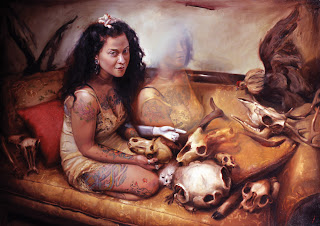
Shawn Barber is a SF based artist and illustrator who has worked for a number of clients such as Target, Subway, Rolling Stone, The Wall Street Journal, to name a few.
He recently painted a portrait of Barack Obama for inauguration day.
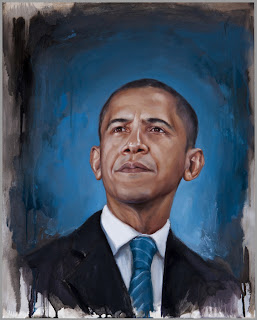
Having significantly worked as an illustrator and teacher, Shawn Barber has turned to more personal work such as “the doll series”, and his giant undertaking “Tattooed portraits”.
Tattoos serve as the perfect medium for expression on a body besides evident expression and pose, they are a reflection of the person and evidently contribute to a more complete portrait. The sitters are revealing not only their figures when they unclothe themselves, but their personal markings and symbols.

In some instances the tattoos overwhelm the figure continuing onto the picture plain, having more significant than the face and body.
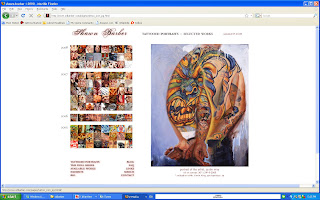
Shawn Barber manages a blend between the realism of tone and colour of the figure, and the design of the tattoos. Often the intensity of the tattoo seems to overwhelm the canvas and take a life of its own.
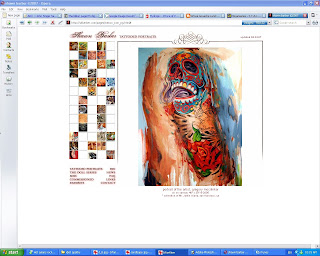
the following Q&A is from the FAQ section of his website sdbarber.com
"I noticed your illustration style and your regular painting style to be quite different, what changes do you have to make in your style in order to paint a successful illustration (as opposed to the more "fine art" style, so to speak)?"
"my paintings are completely different than what i do commercially. the paintings are much larger- avg 5 ft.- and they become finished works through the process. they are much more ABOUT process and the experience of painting, where as the illustrations are direct, interpretations of my sketches. it's a different mindset for me. i have no time restrictions or obligations to anyone but myself and my own aesthetic when i paint these large works. i don't show them in galleries and i basically make them because i want to, and i have to. it's a way for me to release myself, my stress, my thoughts, my past, my fears - everything is dealt with when i paint. time does not matter and has no bearing on these works. i make them for me and others seem to enjoy them- but i make them because i want to express myself through this medium. if i was a singer or songwriter i would be in a band, but i'm not. i'm a painter. the illustrations are a lot of fun for me and they offer different challenges. they are fairly quick and because of that i don't get too emotionally attached to them. they allow me the opportunity to paint every day and i have the freedom of time when i don't have an assignment."

What advice would you give a new illustrator / artist in general? (style, the business itself, etc . . . )
• #1- "be true to yourself and your art. i see too many carbon copy cats out there that are denying there own work. influence is one thing, but stealing is not only unethical, it's disgusting and totally disrespectful. • get the gag book (for any and all questions regarding the business side)- * be patient. be persistent. draw, draw, draw, draw, draw. draw from life- draw from memory, try to stay away from drawing strictly from photos. paint, paint, paint, paint, paint. look at old masters and copy their works. read, read, read, read. read everything- i would suggest reading a few specific books... ben shahn's 'the shape of content' ; robert henri's 'the art spirit' ; jospeph campbell's 'the power of myth' ; krishnamurti's 'the first and last freedom' ; carl jung's 'psychological reflections' ; and laurence g. boldt's 'zen and the art of making a living'... put together a strong body of work (minimum of 10 pieces) and send out portfolios to the specific people that YOU want to work with / for. ( i call them my "hit list"- i keep sending them books until they hire me...) print out postcards and send them to who YOU want to work for / with. you can get names and addresses from the graphic artist's market book, going to the bookstore and looking at EVERYTHING that uses illustration and send your work to them. target a market. i've targeted doing graphic portraits as a starting point for a career in this field.... then expand on that and branch out. only make images that YOU want to make- if you make what you THINK people want and you hate doing it, they will probably hire you to do what you DON'T want to do- so do what makes you happy...put your work on the internet-"
Shawn makes some interesting points about being an artist.
“Being a Professional Artist"
"Be Prepared to Struggle The life of a freelance / self employed / gallery artist is not an easy one. It definitely has it's ups and downs. The pros- you can be creative everyday, you can set your own schedule, you can travel whenever you like, you are in control of your day to day, including your future... The cons- inconsistent cash flow, stress of not knowing when work will come, sometimes you have to do work that is less than exciting, no health insurance, bills sometimes get paid late... Be Down for the Long Haul It's not going to happen overnight. If you're lucky- in 5 years you maintain some sort of consistent work flow, sales and success. For most, it takes 7-10 years. The first 3 years are the hardest. With a lot of people, these are the 'make-or-break' years.
Frustration, lack of motivation, laziness, insecurity and lack of drive will overwhelm most people who even think about being an 'artist'. You can't claim to be something if you make no effort or have no aspirations. Wanting to be and being are two completely different people. Make a list of goals, no matter how lofty, outrageous or small they may be. Work diligently and daily until you achieve these goals. Appreciate and celebrate the small successes, but stay hungry and keep your focus on the future and the unaccomplished goals. Put yourself around successful, healthy and creative people. If your friends are excited about life and what they do and who they are, that energy is contagious. People that have no drive, no direction or aspirations are dead weight- they are going nowhere, talk about the same things and, typically, their depression and negative energy will affect you and take you away from your own goals.
Sometimes it's difficult, but if someone truly cares about you, they should be happy for your success and dedication, not jealous, bitter or resentful. Life is way too short. Be honest with your work and your weaknesses. You HAVE to be your own worst critic. Do not settle for where you are. You should constantly strive to get better and learn something new. Complacency turns into laziness, which falls into boredom and mediocrity. Why do something if you don't care about it? No one is 'making you' do it. If art is a hobby, that's all well and good- but don't fool yourself and think you're something that you're not. Be humble. Realize that you're not that good. There are 10,000 artists living that are better than you. There are 100,000,000 in art history that are even better. Feel good about what you do but don't lose sight of this reality. Challenge yourself to do things you don't think you can do, either out of fear or lack of knowledge. Expose yourself to ALL kinds of art- painting, sculpture, film, furniture design, illustration, architecture, animation, etc. Ask yourself WHAT and WHY you like certain aspects of your favorite art pieces and allow that to nurture, inspire and motivate your own work. More than anything stated, the most important ideal is to HAVE INTEGRITY.

Stand behind what you do, have your own voice, your own aesthetic and your own opinions. Don't try and be the 'Flavor of the Month'. Please, Please, Please- whatever you do, don't be a jackoff. The art world is very small. Don't let yourself get labeled as a clone, a copycat, a spineless, unoriginal bastard. No one will respect you or your work. It's lazy and unethical, disrespectful and disgusting. Don't turn work or commissions down. No job is too small. Sometimes, you even have to do work for free.... ALWAYS be professional. Try to challenge yourself and take on more than you can handle. You will be surprised, when it comes down to crunch time, if you focus and make deliberate decisions and actions- you will accomplish much more than you thought you were capable of.”

Shawn Barber is a contemporary artist and illustrator whose work ethic and artistic practice has had a strong impact on my own art. He is tirelessly dedicated to his craft, prolific and brilliant. I hope you enjoy his work.
Life Drawing Reflection
I have been going to open life drawing at Adelaide Central School of Art (ACSA) most weeks this year on a Thursday night. Drawing begins at 6:00 pm and concludes at 9:00 pm with a short break in the middle. Each week, artists and art students arrive with a number of materials, conte, charcoal, gouche etc and draw or paint the figure in whatever fashion they want. Because the class is “open” there is no teacher present, only an organizer who sets the timer for each pose. This allows those attending the freedom and opportunity to create without the dictating presence of a teacher.
Usually I begin by drawing small studies into my sketchbook in pen or pencil, sometimes favoring a brush pen when the pose suits it. Poses start at 2 minutes, and gradually increase in time, the final pose being between 30 minutes and an hour. Because I usually choose work on smaller drawings, the shorter poses suit me. On longer poses I tend to lose concentration and lose interest.
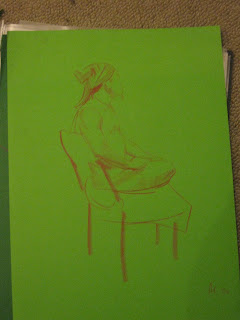
Over the weeks I have attended this class I have used a number of drawing tools, such as charcoal, pen, pencil, conte, brushpen and coloured pencils. Approaching the figure from life, I find the structure of the figure the most interesting. Light, musculature, line and tone are all aspects relevant to studying and observing the figure, however the structure is crucial in establishing a convincing figure. By structure, I am referring to the interlocking anatomy and shapes of the figure. How the ribcage connects with the arms and neck, how the bottom connects with the leg, how each limb is connected. It is this approach that seems the most logical to me, although it doesn’t suit everyone.
Walking around the life drawing room reveals a number of different intentions and styles. Some artists prefer to draw solely the face, some make only gestural marks indicating the flow of the figure.
Each week there is usually a different model. Having variation in models has allowed me to see how different and similar bodies are. Some models are thin, their ribcages visible, thighs slender and long, other models are larger, rounder, with softer curves. Model variation allows the artist to draw the figure with different approaches. Drawings of thin models suit hard line drawings and sharp silhouettes, with the emphasis on slender lines. Larger models suit drawings with heavy tone, usage of charcoal for getting light and shade looking 3-d.
Having both male and female models has also shown me how variation in drawing style suits different shapes. Men have squarer torsos, more suited to cubes and rectangles. Women have more elegant torsos, suited to curvy lines.
Life Drawing has been a crucial part of my extension studies program. It has allowed me to interact with other artists and observe the figure from life (primary research) and has been integral in the practical component of this study. The life drawings I complete are part of my folio, with some being part of the exhibition.
Usually I begin by drawing small studies into my sketchbook in pen or pencil, sometimes favoring a brush pen when the pose suits it. Poses start at 2 minutes, and gradually increase in time, the final pose being between 30 minutes and an hour. Because I usually choose work on smaller drawings, the shorter poses suit me. On longer poses I tend to lose concentration and lose interest.

Over the weeks I have attended this class I have used a number of drawing tools, such as charcoal, pen, pencil, conte, brushpen and coloured pencils. Approaching the figure from life, I find the structure of the figure the most interesting. Light, musculature, line and tone are all aspects relevant to studying and observing the figure, however the structure is crucial in establishing a convincing figure. By structure, I am referring to the interlocking anatomy and shapes of the figure. How the ribcage connects with the arms and neck, how the bottom connects with the leg, how each limb is connected. It is this approach that seems the most logical to me, although it doesn’t suit everyone.
Walking around the life drawing room reveals a number of different intentions and styles. Some artists prefer to draw solely the face, some make only gestural marks indicating the flow of the figure.

Each week there is usually a different model. Having variation in models has allowed me to see how different and similar bodies are. Some models are thin, their ribcages visible, thighs slender and long, other models are larger, rounder, with softer curves. Model variation allows the artist to draw the figure with different approaches. Drawings of thin models suit hard line drawings and sharp silhouettes, with the emphasis on slender lines. Larger models suit drawings with heavy tone, usage of charcoal for getting light and shade looking 3-d.
Having both male and female models has also shown me how variation in drawing style suits different shapes. Men have squarer torsos, more suited to cubes and rectangles. Women have more elegant torsos, suited to curvy lines.
Life Drawing has been a crucial part of my extension studies program. It has allowed me to interact with other artists and observe the figure from life (primary research) and has been integral in the practical component of this study. The life drawings I complete are part of my folio, with some being part of the exhibition.
Sunday, August 16, 2009
Exhibition Reflection 2

As the artworks are being taken down from the first exhibition (see earlier post), others are being put up elsewhere. Earlier this year, I participated in a youth art class organized by the Art Gallery of South Australia (AGSA). The Class occurred over 2 days, being led by local artist Trevor Newman. The subject of the class was self portraiture.
The first day began with introductions and a viewing of artworks from the AGSA’s permanent collection. Images by prominent Australian artists such as Mike Parr and Ivor Hele were shown among a diverse collection of artist’s styles. Trevor Newman gave a short lecture on the significance and practice of self portraiture and demonstrated some practical art skills. Students returned to their easels, brimming with inspiration and ideas, sheets of paper and charcoal in hand. Each student had a mirror to draw from and a supply of art materials.
Students then began to draw their appearance. My first portrait was done on toned paper with red conte. My intention was for an accurate likeness. I first began by drawing the shape of my head, then massing in the tone and form of the face. The face was separated into roughly 5 tones, the paper tone, white conte, soft red tone, hard red tone and black charcoal. As the likeness emerged, I received comments from instructor Trevor Newman. He was pleased with the emerging likeness and had some advice for getting the tones accurately. As I completed this first portrait, Trevor approached me and instructed me to create another self portrait, this time less concerned with my “bread and butter” traditional approach.

I got new sheets of paper, another colour of conte and began my second drawing. I drew quicker, spontaneously, not concerned with absolute realism. I redrew my head from other angles, giving the impression of movement. I created a third drawing in a similar matter.

The following day Trevor gave an evaluation on the progress of students. Each student was approaching the subject differently. Some drew with soft delicate lines, others drew with force and dynamism, others simplified and some exaggerated. The magnitude of different styles and skills was overwhelming. Trevor was pleased with the progress of my drawings and had succeeded in getting me “out of my comfort zone” and into unknown territory. His persistence and energy for me to branch out and attack the subject anew gave me confidence and vigor.
I completed another self portrait, using the first traditionalist drawings as a prop against the mirror at a skewed angle, to redraw the portrait from a new angle, not using my face as the reference, but using the drawing of my face as reference.
This was conceived as an experiment after having seen Mike Parr explain his process for drawing images such as this image below
at the Summer Art Scholarship earlier this year.
I created 2 quick drawings in this manner. The second day had concluded and Trevor gave a finishing speech. He was pleased with the progress of all the students and interested in my future plans as an artist.
This experience was rewarding and enjoyable. I felt I was challenged as an artist and that the outcomes of my drawings were successful. I had gained a contact in Trevor Newman and interacted with students my age with a similar interest in drawing.
…….
On Friday the Fourteenth of August, the works of participating students were hung in Carclew Youth Arts Centre. The exhibition was in a large room, and the drawings were all mounted and hung close together. The room was packed with the students and their parents. My artwork was hung as a series of three, the traditionalist drawing on the end and the looser drawings beside it. Although I had outlined the hanging order ( which image next to each image), the images were hung according to colour choice( Red, Blue Red), I had originally intended the realist drawing to be in the middle.
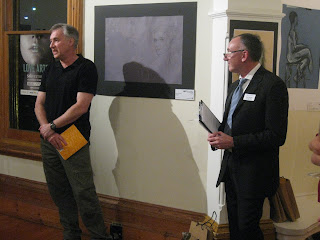
Speeches began at 8pm by Mark Fisher, head of the education department at AGSA who welcomed those attending. He gave a brief overview of the self portraiture course then began to award prizes for participants. The exhibition was a joint exhibition with a life drawing class, and the figure prizes were announced. Mark then announced the winner of the Self Portrait class.
Mark called my name and I accepted the prize to my nervous horror. I accepted the prize (I received the book- LETS FACE IT: THE HISTORY OF THE ARCHIBALD PRIZE, the 2009 Archibald Prize catalogue, a certificate and a gift voucher to the AGSA bookshop) and stopped to have photographs taken. I have an ambivalent attitude to art exhibitions having some element of contest, of winners and losers. On one side, it is fantastic to be rewarded on artistic achievements and hard work, but on another side it can be devastating not winning. Also when it comes to judging artworks, bias is always inherent, and judges often make puzzling decisions.


After I was awarded the prize I was approached by a number of people asking about my intent with the images and future plans regarding art. The experience had similarities to my earlier exhibition (see earlier post). Interacting with strangers who ask very direct personal, probing questions is sometimes difficult. Although I do not feel entirely self conscious, I find myself anxious projecting myself to people I do not know.

The experience was largely pleasant, the artworks were all hung well and the exhibiting space had good light. I received a number of warm compliments and congratulations from people which was nice. Having my artwork hung in a group context was good to see the range of different styles. The experience was a lot of fun and made me feel engaged in the local art world.

Subscribe to:
Posts (Atom)

